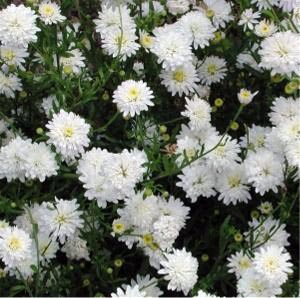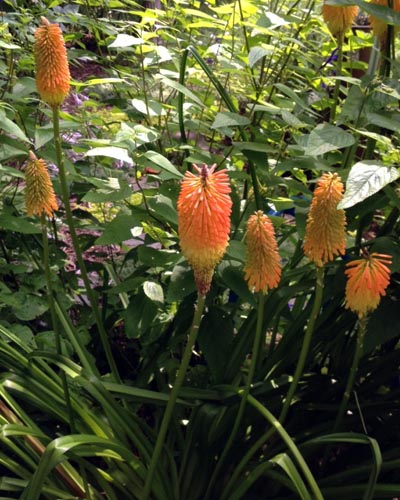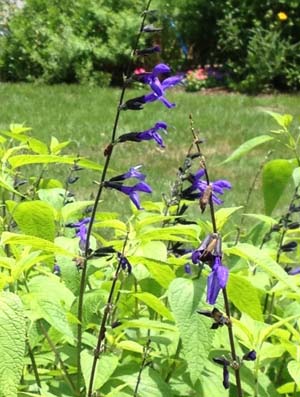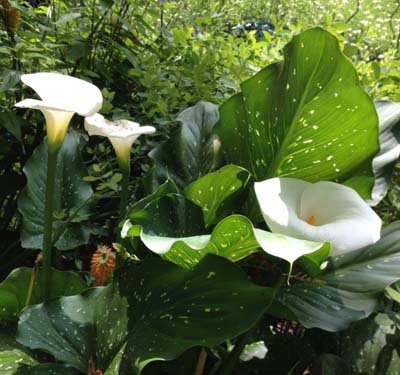Five Easy Plants for the Busy Gardener to Grow
By Gil Medeiros, Fairfax Master Gardener
People choose a plant for their garden for many reasons: It might be especially beautiful, or unusual, or reminiscent of a plant Grandma grew in her yard. But for busy gardeners, what perhaps should matter most is whether a plant is easy to grow. After all, when you don’t have much time – or desire – to fuss, easy sounds pretty good.
Here are five perennials that fit that category. Each has performed well in our gardens over several years, requiring virtually no care. Don’t be surprised if you have never seen or heard of them, as they are neither native to our area or a common choice for local landscapes. (Fairfaxgardening.org will offer suggestions for easy native plants, however, another time.)
 1. Asteromea mongolica (Japanese Aster)
1. Asteromea mongolica (Japanese Aster)
Seldom do we find a plant that requires no maintenance at all, however, Asteromea mongolica is one of those plants. Pick it up at the garden center, plant it in full sun, and go away. Good soil or bad; this plant does not care. I don’t even water the ones in our gardens. From year to year, the clump expands a little. Since it is herbaceous, it dies back in winter; you will want to clear away the dead stems in early spring. That’s about it.
Asteromea mongolica begins its profusion of blooms in June and continues through October! It produces white, aster-like flowers with yellow centers. The plant is carefree: no pests, no diseases.
When we bought this plant in 2013, it was called false aster, and it had a different botanical name: Kallimeris pinnatifida ‘Hortensis.’ Although the plant has been reclassified, the garden center may still know it by its old name.
 2. Kniphofia ‘Lola’ (Red Hot Poker)
2. Kniphofia ‘Lola’ (Red Hot Poker)
If you want to make a bold statement in the garden, Red Hot Poker is for you. Also known as torch lily, it grows to 3 feet in our garden, but some growers say it can reach 7 feet. In early July it produces large, fiery orange-red flower spikes that protrude well above the foliage. Hummingbirds are frequent visitors.
Kniphofia ‘Lola’ originated in Africa. It is herbaceous. The basal leaves remain green in my garden throughout the winter; the top foliage dies back and should be removed in early spring. That is the only maintenance required. Plant it in full sun.
3. Salvia guaranitica ‘Black and Blue’
I have tried a few salvias with mixed luck. This herbaceous perennial, however, is a clear winner.  It grows 5 feet tall in our gardens. The deep-blue flowers appear in June and last until the frost. The flowers are small and, if you are a human, not especially eye-catching. However, hummingbirds and butterflies flock to them.
It grows 5 feet tall in our gardens. The deep-blue flowers appear in June and last until the frost. The flowers are small and, if you are a human, not especially eye-catching. However, hummingbirds and butterflies flock to them.
A native of South America, this one is listed in some literature as a zone 8-10 plant. In my garden, however, it has survived the polar vortex winters without a hint of trouble and with no added mulch for protection. Also, some literature says black and blue salvia is susceptible to powdery mildew. Believe me, I know powdery mildew from direct experience. My cukes get it and so do my zucchinis and garden phlox. I have never seen powdery mildew on the black and blue salvias.
The clump expands a bit each year and needs to be cut back occasionally. Cut the old stems to the ground in early spring. Otherwise, this one is maintenance-free.
 4. Clematis paniculata, (Sweet Autumn Clematis)
4. Clematis paniculata, (Sweet Autumn Clematis)
This New Zealand native is nothing short of spectacular in late summer when it is in full bloom. It is covered with white flowers for about three weeks. It grows fast with vines up to 30 feet long. Provide a trellis or fence to support this plant, or cut it back to 12 inches in spring and grow it as a shrub. Flowering will not be affected because it blooms on new wood.
The literature says it needs at least six hours of sun; our experience confirms that. The literature also says it needs to be fertilized annually. It has done very well here without fertilizer.
All parts of this plant are known to be toxic. Take care if you have pets or small children.
 5. Zantedeschia aethiopica ‘White Giant’ (Calla Lily)
5. Zantedeschia aethiopica ‘White Giant’ (Calla Lily)
Large, white flowers grace this plant from mid-spring to mid-summer. Both its jack-in-the-pulpit-type flowers and its yellow-speckled, broad green leaves are eye catchers. It grows from rhizomes and reaches 2 to 3 feet tall.
White Giant has been a reliable, no-maintenance plant in our garden in full sun and clay soil. Some references say it is winter-hardy only to zone 8. Ours has survived with no problems and no protection through the polar vortex winters. Nor have I had any pest or disease problems.
There is one caution concerning this native of Africa: If you have small children or pets, know that all parts of the plant are poisonous.
References
Japanese Aster, University of Arkansas Cooperative Extension Service
Clematis paniculata, NC State University Cooperative Extension
Kniphofia uvaria, NC State University Cooperative Extension
Salvia guarantica, Missouri Botanical Garden
Zantedeshia aethiopica, Missouri Botanical Garden